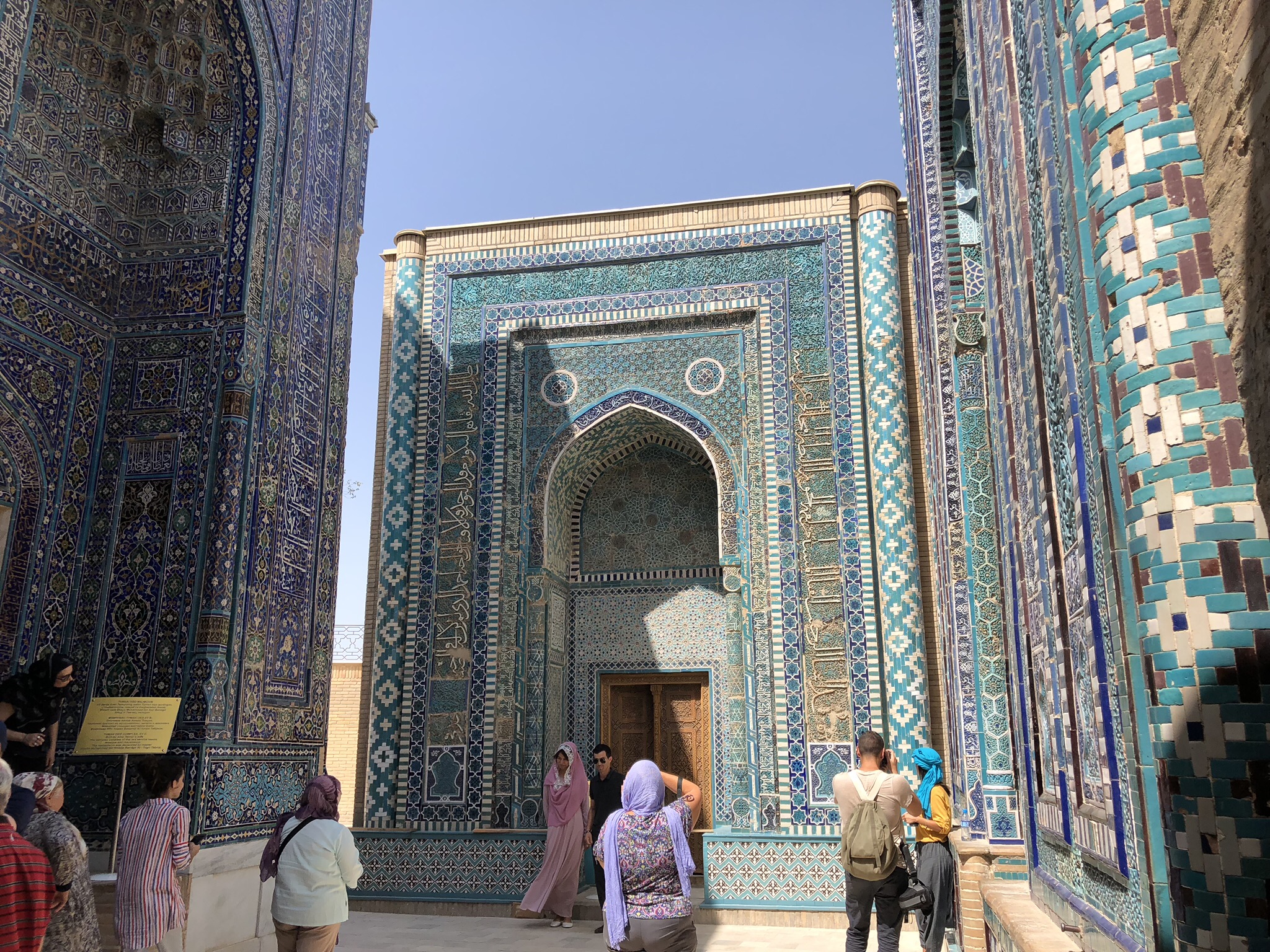Days 13 and 14 - Samarkand
23 August ’18

The Registan lit at night

Gravestones in Samarkand’s cemetery

Necropolis of Samarkand

Necropolis of Samarkand

Woman praying in the Bibi Khanum Mosque

Ongoing renovation works at the Bibi Khanum Mosque

Tamerlane’s Mausoleum
We take a train for a two hour trip that will lead us fro Bukhara to Samarkand. This time we’re in a first class cabin of an old train. Our wagon only has first class cabins for two, so we’re all alone. Instead of seats, we have beds, so we get some sleep. We arrive in Samarkand at 7pm and take a cab to our hotel, more precisely a guesthouse not very far from the city center. Our hosts look nice, and the guesthouse is simple but comfortable enough for spending one night. Only problem: no Internet. The guy gives us the password for his WiFi, but the network simply doesn’t work. We’ll do without.
We go out for a walk in the evening and have the greatest surprise to discover a light show projected of the facades of the Registan complex: different lights and images tell the history of the main civilizations of the world and particularly those who influenced the silk road. A delegation of Japanese tourists have been specially welcomed with a VIP location, while the rest (including us) watched the spectacle some meters behind. In the end, the police opened the ways for everyone to come closer to the buildings, which are simply amazing, full of colors and incredible details of rich Arabic art.
It’s already late evening, but we have the time to taste (or so we can say) yet another dinner cooked in the microwave oven: we guess it’s a must for touristic cities - and we’re still not used to it!
The morning after, it’s time to visit the older part of Samarkand, composed of the Bibi Khanum mausoleum and mosque, the biggest of all Central Asia. After wars and earthquakes, the mosque is basically rebuilt from the ground up, with some ancient frescoes surviving - at least before ulterior renovations are finished. Despite the extreme overhaul the monument (as most Uzbekistan monuments) has gone through, this gigantic building acts very much as a place of pilgrimage for women across Central Asia. Many of them come praying here, venerating one of the main female icons of the Islamic world.
A few hundred meters away, the Mosque dedicated to the prophet Eliah is now basically dedicated to the honor of the late president of Uzbekistan, Karimov, passed away last year and buried in this place. On top of the hill, we visit the local “Père Lachaise”, with Uzbek personalities deserving a large marble portrait on their gravestones. On the same hill, one of the highlights of our day in Samarkand is the Necropolis of the Timurids, also hosting the burial place of the much venerated cousin of the prophet Muhammad, Kusam Ibn Abbas. As in the Registan, the richness of the ceramics, the cupolas nand of some of the internal decorations is striking.
It’s the very last day of our journey: a bit of blues and the heat are taking a toll on us. We get back to our hotel to finish packing before our flight home tonight and also to take a nap.
At 7 PM we’re ready to go back to the city and visit the simple mausoleum of Ruhabad, mentor of Tamerlane. Here, an old man tries to provide us with some explanations about the place in an extremely basic English. We’re about to wholeheartedly thank him when he shows a price list for his services. We find ourselves negotiating once again, with a reduction of more than 50% on the requested amount!
The mausoleum of Tamerlane, Uzbekistan’s greatest hero (after Karimov, apparently) and true icon of the whole Central Asia, sits just behind. We pay the ticket for entering and a few steps later a smiling guide welcomes us and asks if we’d like to have a guided visit of the place, paying of course. The requested price is, apparently, offer-based (“it’s up to you, you pay what you want”). Unsurprisingly, when we propose ours, the guide promptly asks for the double, which we refuse. And here goes the last (failed) negotiation of our trip: Samarkand’s not a land for hard bargainers.
The burial place features the richest decoration we’ve found since the beginning of our trip: ceramics painted in blue and gold cover the internal walls and the 30m cupola. After visiting, we get something to eat in a restaurant, again not very good (we had no luck eating in Samarkand), and head to the hotel to grab our stuff and wait for the taxi that will lead us to the airport.




























